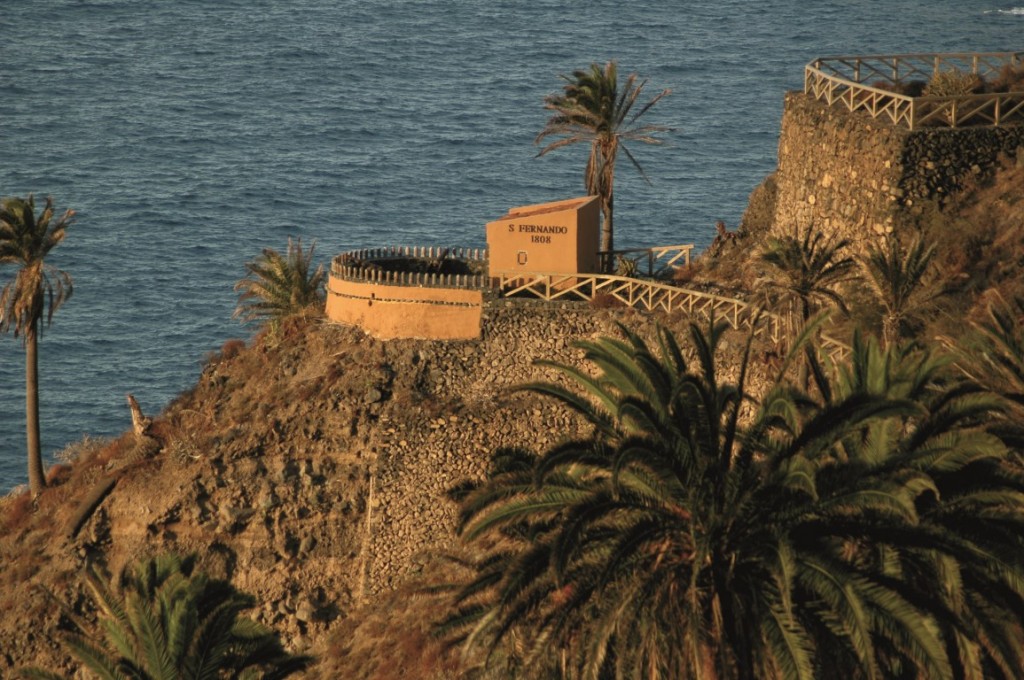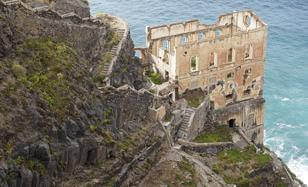Plan your next adventure
Tailor your own route along Tenerife’s trails quickly and easily..
Go to planner
La Rambla de Castro was declared a protected landscape because of its beauty, the value of its ecosystems, and its cultural significance on the island.
Recommended time to visit: All year-round.
The motion of the sea has given form to this coastline, which today is made up of monolithic rocks in the ocean, tall cliffs, headlands, coves and beaches.
This area has been populated by humans throughout history, and today contains nine archeological sites that date back to the time of the original Guanche settlers. These sites include a conchero (pile of shells), a funerary cave, cazoletas (cup marks) and numerous cave dwellings containing remains of ceramics, local molluscs, carved obsidian, and sheep and goat bones.
It was named the Rambla de Castro after the land was awarded to the Portuguese Hernando de Castro, following the island’s conquest. Later it became a popular spot for naturalists and notable figures such as Berthelot, Verneau, Coquet and Leclercq.

Dominating the vegetation is the Canary Island date palm, which occupies the watercourse of the Castro ravine, alongside other ornamental species and some reintroduced dragon trees.
There is also some well preserved coastal vegetation in the area of Guindaste, La Fajana and La Gordejuela, with species such as perejil de mar (Crithmum maritimum), tomillo marino (Frankenia capitata), sea lettuce (Ulva lactuca), magarza (Argyranthemum frutescens), St John’s Wort, barrilla (Mesembryanthemum crystallinum), barrilla (Tusilago canario) and the siempreviva de mar (Limonium pectinatum).
You will also come across areas with cardón (Euphorbia canariensis), balsam spurge (Euphorbia balsamifera), tabaiba amarga (Euphorbia lamarckii), guaydil (Convolvulus floridus), orobal (Withania aristata), tajinaste gigante (Echium giganteum), and cornical (Periploca laevigata); as well as bejeque (Aeonium canariense), pastel de risco (Aeonium tabuliforme), bejequillo (Aeonium spathulatum), and cerraja (Sonchus acaulis) on the cliffs.
Finally, there are a few Canary willows (Salix canariensis) and some tarajal (Tamarix canariensis) at the playa (beach) de Castro.
In terms of fauna, there is one particular invertebrate of note, the polilla canaria de estuche, a moth which is endemic to Tenerife, La Palma and Gran Canaria. Females of this moth type don’t have wings, and spend their lives inside a pyramid-like structure that it builds using plant remains when it is a larvae. The male has wings but doesn’t feed, and spends its short life searching for a female to reproduce.
Among the vertebrates, you will find reptiles such as Gallot’s lizard, skinks and geckos.
You will also be able to spot numerous bird species, such as the Eurasian sparrowhawk, kestrel, plain swift, Berthelot's pipit, Eurasian blue tit, long-eared owl, barn owl, Sardinian warbler, grey wagtail, and Scopoli's shearwater.
Mammals of note in the area include the Madeira pipistrelle, lesser noctule, and European free-tailed bats.

45.9 hectares (0.2% of the island)
Canary Island date palm (Phoenix canariensis), perejil de mar (Crithmum maritimum), tomillo marino (Frankenia capitata), sea lettuce (Ulva lactuca), magarza (Argyranthemum frutescens), St John’s Wort, barrilla (Mesembryanthemum crystallinum), barrilla (Tusilago canario), siempreviva de mar (Limonium pectinatum), cardón (Euphorbia canariensis), balsam spurge (Euphorbia balsamifera), tabaiba amarga (Euphorbia lamarckii), guaydil (Convolvulus floridus), orobal (Withania aristata), tajinaste gigante (Echium giganteum), cornical (Periploca laevigata), tarajal (Tamarix canariensis), Canary willow (Salix canariensis), Canarian estuche moth, Gallot’s lizard, skink, gecko, Eurasian sparrowhawk, kestrel, plain swift, Berthelot's pipit, Eurasian blue tit, long-eared owl, barn owl, Sardinian warbler, grey wagtail, Scopoli's shearwater, Madeira pipistrelle, lesser noctule, European free-tailed bat.
Tabaibal-cardonal.
Casa de Los Castro, El Guindaste, La Fajana, playa de Castro, La Gordejuela.
To consult permits for use and updated regulations for this Protected Natural Area, visit the official website of the Government of the Canary Islands.

These are some of the points of interest you can find along this route.

Fortín de San Fernando
Small 18th-century fortress built to defend the coast from attacks, which still preserves three...

La Gordejuela Pumping Station (Casa del Agua)
Ruins of the old Gordejuela water elevator, where the first steam engine used to pump water in...
Tailor your own route along Tenerife’s trails quickly and easily..
Go to planner